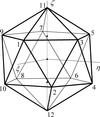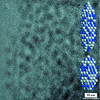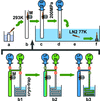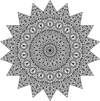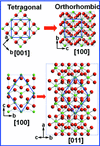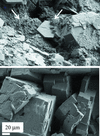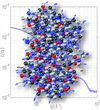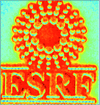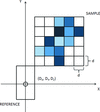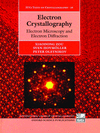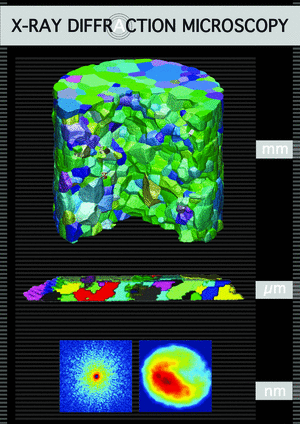issue contents
April 2014 issue

Cover illustration: A TEM image of a representative region of a CdS nanoparticle sample, overlaid with depictions of the spheroidal morphology and atomic structure of CdS nanoparticles obtained from (top) a pair distribution function (PDF) fit and (bottom) a PDF/small-angle X-ray scattering co-refinement. Courtesy of Farrow et al. [J. Appl. Cryst. (2014), 47, 561-565].
research papers
A method for energy-dispersive X-ray diffraction mapping is presented, using a conventional low-power benchtop X-ray fluorescence spectrometer. Maps are presented for Bi, Pb and steel shot gun pellets and the capability for lower atomic number and lower-symmetry materials is briefly explored.
A single-scan approach to evaluating chemical and structural gradients in polycrystalline thin films with a resolution of tens of nanometres is reported. Thinned samples are measured in cross section in transmission geometry with a high-energy X-ray nano-pencil beam.
Under identical growth conditions, self-assembled Au droplets show significantly different size and density depending on the amount of Au deposition. With relatively low Au deposition amounts, below 3 nm, round dome-shaped mini Au droplets with high packing density can be fabricated, while super large Au droplets result with higher deposition amounts, above 10 nm, with a density two orders of magnitude lower.
Energy-dispersive synchrotron diffraction was applied to analyse the near-surface residual stress state in polycrystalline materials. A Rietveld-based formalism is introduced which permits a full triaxial data evaluation and, therefore, even the detection of out-of-plane σ33(z) gradients.
Single-crystalline GeS nanosheets and nanowires can be selectively synthesized by changing the reaction conditions. The samples were characterized using X-ray powder diffraction, transmission electron microscopy, energy-dispersive X-ray spectrometry and scanning electron microscopy. The growth mechanism of GeS nanowires is proposed to be via a rolling-up process.
The parametric refinement of rotational rigid-body symmetry modes is demonstrated for the cubic monoclinic phase transition in Mg(H2O)6RbBr3.
A universal algorithm for the generation of three-dimensional models of icosahedral fullerene-like carbon nanostructures has been developed.
The displacive diffuse scattering from triglycine sulfate, (NH2CH2COOH)3·H2SO4, has been modelled using several approaches, to determine which is preferable and as a guide for analysis of similar compounds.
The application of the atomic pair distribution function for the purpose of obtaining the intergrowth amount of pyrolusite (β-MnO2) and ramsdellite (R-MnO2) in γ-MnO2 is demonstrated. The presented model opens the door to intergrowth quantification in numerous materials where the two structural components are clearly distinguishable.
A complex modeling approach that combines atomic pair distribution function and small-angle X-ray scattering data from CdS quantum dots yields more robust and accurate structural and morphological parameters when compared with either single technique alone.
Temperature-dependent optical rotatory power can give valuable information on the achiral optical properties of orthorhombic crystals of which only a few measurements are known. The high-accuracy universal polarimeter technique was successfully applied to determine the optical rotation in the presence of birefringence of potassium titanyl arsenate (KTA) and potassium titanyl phosphate (KTP) biaxial crystals.
A method for accurate measurement of the texture of thin oxide films has been proposed. The method involves the separation of integrated intensities from complex glancing-angle diffraction spectra and leads to an improved representation of the preferred orientation present in oxide films.
A high-pressure system for cooling cryoprotectant-free biological crystals has been designed for automated data collection on synchrotrons. The apparatus and the method have been validated with a series of test samples.
A new algorithm, CONOGRAPH, carries out exhaustive powder auto-indexing in a short time, even if the q values of many peaks are used for robust powder auto-indexing. Some results from CONOGRAPH are presented.
This article desribes the neutron diffraction properties of a double-crystal (+n,−m) setting, which contains a bent perfect Si(311) crystal in the fully asymmetric diffraction (FAD) geometry with output beam expansion and a bent perfect Si(220) crystal in the symmetric diffraction geometry. After beam expansion, this FAD geometry provides a beam of large cross section but small divergence.
Crystallographic features of a hypoeutectic Zn–Al alloy were significantly affected by the presence of a high magnetic field during the solidification process.
It is shown using grazing-incidence small-angle X-ray scattering experiments that a series of NIL polymer gratings with different line quality present characteristic features that can be associated with the level of defects per line.
Simultaneous fitting of small- and wide-angle neutron/X-ray total scattering data for nanoparticles has been evaluated using both simulated and experimental signals.
Quasiperiodic tilings constructed by the multigrid method and decorated by rosettes constructed by craftsmen are studied.
Small-angle scattering from polydisperse non-homogeneous particles with a diffusive interface is considered for the case of low diffusivity. The deduced simplifications in the analysis of both the polydispersity and the inner structure (contrast variation) of the particles are used in the treatment of small-angle neutron scattering data from liquid dispersions of detonation nanodiamond.
1-Chlorododecane dispersed in dodecane is proposed as an absolute scale calibration standard substance for small-angle X-ray scattering.
Download citation


Download citation


By collecting multiple mixture powder diffractograms and deconvoluting them into the individual components using the band target entropy minimization algorithm, single-phase powder diffractograms are obtained. From these, structure solutions and refinements are achieved with standard crystallographic techniques.
LCDiXRay, a user-friendly program for the indexing of powder X-ray diffraction patterns of columnar liquid crystals, is presented. The program allows straightforward determination of structural parameters of columnar mesophases.
A way of determining layer structure in terms of Patterson analysis is demonstrated for a simulated X-ray reflectometry measurement. This article is the sequel to a recent publication where the technique was demonstrated for neutron reflectometry.
Owing to the constraint of the twinning interface in tetragonal zirconia nanoparticles, the martensitic transformation induces an adaptive Pbca orthorhombic phase before finally transforming to the monoclinic phase.
A new wireless microdevice manipulates protein crystals using gentle fluid flow. The microrobot is capable of selecting a single crystal from a group and transporting it onto a loop.
The high-temperature phase transition of LuF[SeO3] has been characterized by time-resolved high-resolution synchrotron powder diffraction, and the coupling between the strain and the displacive order parameter has been analysed by parametric refinement using different models.
A new iterative method can extract the size distribution of non-interacting polydisperse spherical particles from a small-angle scattering profile. This method does not demand the consideration of any basis function or depend on any numerical transform.
With an incidence of 1:7000 births, cystinuria is the most frequent genetic disease inducing nephrolithiasis. It is shown that alkalinization with sodium bicarbonate affects cystine kidney stones at the mesoscopic and nanoscopic scales, while other medical treatments only alter their surface, a result which may help to assess the interaction between drugs and cystine stones in cystinuric patients.
New parameters approximating the accurate distances to the nearest symmetric and improperly quasi-symmetric boundaries are defined to speed up analyses of grain boundary networks. The new parameters are used for studies of symmetric and improperly quasi-symmetric boundaries in three-dimensional data of a nickel-based superalloy.
All the possible kinds of phase-transition-induced domain structures in the insulating M1 and M2 phases of vanadium dioxide were theoretically predicted using a general space group method and characterized by transmission electron microscopy.
High-temperature Raman spectroscopy was applied to study the microstructure of the BaO–B2O3–Na2O solution for β-BaB2O4 crystal growth. The Raman spectrum of the growth solution was calculated, and the calculated result coincided well with the experimental result.
Download citation


Download citation


Substitution in the perovskite A site releases internal structural stress as a result of a better matching of the A—O and B—O distances, leading to less distorted phases (transition from monoclinic to orthorhombic). Symmetry-adapted mode decomposition revealed that the out-of-phase tilt of BO6 octahedra slightly varies with Sr content, whereas the in-phase tilt strongly decreases to almost vanish for x > 0.5, anticipating a transition to a more symmetric structure.
Structure refinement protocols based on small-angle X-ray scattering iteratively adjust the posited positions of atoms in a structure via a gradient-based constrained optimization to ensure that experimental scattering profile data are matched. This requires computation of the profile and its gradient with respect to atomic coordinates at every step. The fast algorithms proposed in this article reduce these to a cost that is linear in the number of atoms for any specified accuracy.
A new quick continuous mapping technique that comes together with a software package (XSOCS) for automatic data analysis for strain and lattice orientation is presented as a novel type of scanning probe microscope.
Using the edge-to-edge matching model, electron backscatter diffraction and transmission electron microscopy, good crystallographic matching and reproducible orientation relationships have been identified between refined Al grains and in situ formed pro-peritectic Al3Nb particles. These particles are therefore suggested to account for the considerable grain refinement in the Al alloys with addition of Nb solute.
A method is proposed for determining the scattering length density distribution of a molecular-scale object directly from phase-sensitive small-angle neutron scattering. The structure factor amplitude is obtained through the use of a reference structure for a collection of randomly oriented, identical objects in the dilute solution limit.
The morphology, dimensions and polydispersity of cellulose nanofibers, extracted from wood pulps using the (2,2,6,6-tetramethylpiperidine-1-yl)oxyl (TEMPO)-mediated oxidation method, were characterized by the solution small-angle X-ray scattering technique. A simplified ribbon model was derived to fit the scattering profile with high quality and computational efficiency, and the fitting results were consistent with transmission electron microscopy data.
short communications
A germanium crystal has been bent through a grid of superficial grooves manufactured on the sample surface. High diffraction efficiency was achieved for a monochromatic X-ray beam at 150 and 300 keV and focusing capability has been demonstrated.
computer programs
The fourth version of the program package WinCSD is multi-purpose computer software for crystallographic calculations using single-crystal and powder X-ray and neutron diffraction data. WinCSD covers the complete spectrum of crystallographic calculations, including powder diffraction pattern deconvolution, crystal structure solution and refinement in 3 + d space, reconstruction of electron density from diffraction data, and graphical representation of crystallographic information.
An idealized molecular geometry library has been created as a web site to be used for refinement of difficult structures with constrained fragment geometries. The library application is illustrated with a practical example.
MolScat is an application that computes small-angle scattering intensities from user-provided three-dimensional models. The program can fit the theoretical scattering intensities to experimental X-ray scattering data. SAFIR is a program for interactive rigid-body modelling into low-resolution shapes restored from small-angle scattering data.
book reviews
Free 



 journal menu
journal menu















